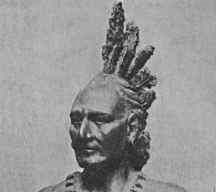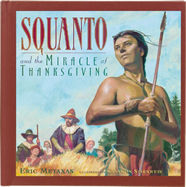|
|
Squanto
Squanto (1585?-1622), Native American of the Wampanoag tribe of what is now Massachusetts. Also known as Tisquantum, he proved an invaluable friend to white settlers in New England in the early 17th century. Early in his life he was captured and sold as a slave in Spain but eventually escaped and went to England. When he returned to New England in 1619 as pilot for an English sea captain, he escaped and discovered that his people had been destroyed by a plague. Two years later he helped the starving Pilgrims at Plymouth Colony to survive by teaching them both fishing and the planting of corn. He developed a friendship with the Massachusetts settlers and acted as interpreter at the Treaty of Plymouth, signed in 1621 between the Native American chief Massasoit and Governor William Bradford. While guiding a party under Bradford around Cape Cod the following year, he became ill and died.

Squanto acted as a guide and interpreter for European settlers in what is now Massachusetts, helping them explore and survive in the new territories in North America. He first aided the starving Pilgrims at Plymouth Colony in 1621, teaching them rudimentary fishing and agriculture. A year later, Squanto became ill and died while guiding members of the new Massachusetts government around Cape Cod.
The History of Tisquantum
Tisquantum was a native of the Patuxet tribe, which lived at present-day Plymouth, and which belonged to the Wampanoag confederation of tribes.
In 1605, Captain George Weymouth led an expedition on behalf of some merchants in England, to look at the resources of North America, particularly the Canadian and New England areas. He sailed down the coast of Maine into Massachusetts, where he stopped. Thinking his financial backers in England would be interested in seeing some Indians, he decided to bring some back with him. They kidnapped two Indians in a very brutal manner, writing "we used little delay, but suddenly laid hands upon them . . . For they were strong and so naked as our best hold was by their long hair on their heads". He had gotten three other Indians to take back to England as well, but he used bribery with them: "we gave them a can of peas and bread, which they carried to the shore to eat. But one of them brought back our can presently and staid aboard with the other two; for he being young, of a ready capacity, and one we most desired to bring with us into England, had received exceeding kind usage at our hands, and was therefore much delighted in our company." That Indian was most likely Tisquantum.
Brought into England, Tisquantum lived with Sir Ferdinando Gorges, whose Plymouth Company had a lot of financial possibilities to exploit in the New World. Gorges kept Squanto, taught him some English, and eventually hired him to be a guide and interpreter for his sea captains who were exploring the New England coasts.
In 1614, he was brought back to America, assisting some of Gorges men in the mapping of the New England coast. John Smith, after he was done mapping the Cape Cod region, left in charge a fellow captain by the name of Thomas Hunt, to trade with the Indians a little more. Once Smith had sailed off, however, Hunt promptly tricked twenty Nausets and seven Patuxets into coming on board his ship to trade--and then kidnapped them. Tisquantum, probably on board to act as an interpreter for the trades, was one of those captured. They were bound, and sailed to Malaga, Spain, where Hunt tried to sell them for slaves at 20 apiece. Some local Friars, however, discovered what was happening and took the remaining Indians from Hunt in order to instruct them in the Chirstian faith, thus "disappointing this unworthy fellow of the hopes of gain he conceived to make by this new & devilish project".4
Tisquantum lived with the Friars until 1618 when he boarded a ship of Bristol headed for Newfoundland. When Tisquantum arrived in Newfoundland, however, he was recognized by Captain Thomas Dermer who happened to be there, and who had worked in the past for Sir Ferdinando Gorges.
Thomas Dermer wrote a letter to Sir Ferdinando Gorges, stating he had found "his Indian" in Newfoundland and asked what he should do with him. Dermer brought Tisquantum back to Gorges. While in England, Gorges apparently boarded Tisquantum with Sir John Slainey, treasurer of the Newfoundland Company. After working out the details, Gorges organized a trip to send both Dermer and Tisquantum to explore the natural resources and to re-initiate trade with the Indians along the New England coast who had been angry with the English after Hunt had kidnapped members of their tribes. At the end of the expedition, Tisquantum would be returned to his home at Patuxet.
Dermer and Tisquantum thus became very closely associated with one another. They worked together mapping the resources of the New England coast. When they arrived at Patuxet in 1619, Dermer and Tisquantum soon found out that the entire Patuxet tribe had been wiped out in a plague in 1617. Squanto was the only Patuxet left alive, so he moved in with a neighboring tribe that lived at Pokanoket--the home of Wampanoag sachem Massasoit. Dermer continued on, and while at Cape Cod, he and his crew were attacked by Nausets, and Dermer was taken hostage. Squanto heard about the incident, and came to his friend's aid, and negotiated his safe release. Dermer would later be attacked by Indians near Martha's Vineyard, and would die of his wounds after reaching Virginia.
Just little more than a year after Tisquantum was returned to his homeland, the Pilgrims arrived--in November 1620. After the Pilgrim explorers checked out all of the surrounding regions, they finally decided to settle at Plymouth in late December. Little did they know that just a couple years ago, Plymouth had been center of the Patuxet tribe.
Two months after settling at Plymouth, an Indian visiting from Maine, by the name of Samoset, walked right into the middle of the Colony which was being built, and welcomed the Pilgrims in English. Somewhat fearful and somewhat astounded, the Pilgrims and Samoset talked all day and night. After Samoset had led several tradings with the Pilgrims, he told the Wampanoag living at Pokanoket that the Pilgrims wanted to make a peace with them. Massasoit sent Tisquantum to be interpreter, and on March 22, 1621, the Pilgrims met Squanto for the first time. That day, Squanto negotiated a peace treaty between Massasoit and the Wampanoag, and John Carver and the Pilgrims. It essentially stated that the Wampanoag and the Pilgrims would not harm each other, and they became a military alliance as well, such that if one were attacked, the other would come to the aid.
Tisquantum lived out the rest of his life in the Plymouth Colony. He befriended the Pilgrims, and taught them how to manure their corn, where to catch fish and eels, and acted as their interpreter and guide. Without Squanto's help, the Pilgrims would probably have had severe famine over the next year, and would have lived in constant fear of their Indian neighbors--Indians who were actually quite peaceful, but who had been rightfully angered by the cruel treatment they received from many English ship captains like Thomas Hunt.
Tisquantum did not help the Pilgrims solely because he was a nice and caring individual. By late 1621 he was using his position with the Pilgrims for his own gain--threatening many Indians that if they did not do as he told them, he would have the Pilgrims "release the plague" against them. As with all humans, "power corrupts". When Massasoit learned that Tisquantum was abusing his position to steal power, he demanded Squanto be turned over to him to be executed. The Pilgrims were required to turn Squanto over, according to the peace treaty they had signed with one another. But the Pilgrims felt they needed Squanto's services, so they stalled--until an English ship came onto the horizon, and distracted everyone's attention for awhile.
But in November 1622, while on a trading expedition to the Massachusetts Indians, Tisquantum came down with Indian fever, his nose began to bleed, and he died. Governor William Bradford, perhaps Squanto's closest friend and associate among the Pilgrims, wrote the following about his sudden death:
In this place Squanto fell sick of an Indian fever, bleeding much at the nose (which the Indians take for a symptom of death) and within a few days died there; desiring the Governor to pray for him that he might go to the Englishman's God in Heaven; and bequeathed sundry of his things to sundry of his English friends as remembrances of his love; of whom they had great loss.

Squanto - Article about this English speaking Indian who helped the Pilgrims. Squanto - God's Special Indian - Story of the role played by Squanto in helping the Pilgrims. Squantum (Squanto) and Cupids - Biographical article about the Native American man who reportedly attended the first Thanksgiving.
|
|
|
|
|
 Native American Nations
Native American Nations
